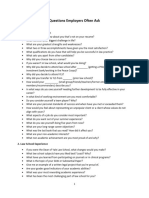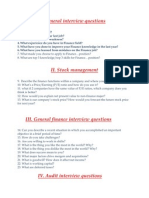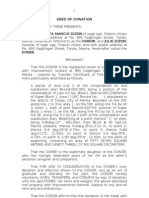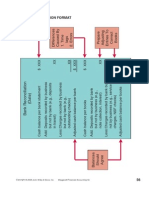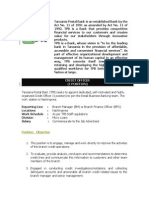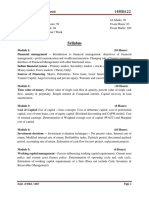2010 Midterm Exam Review
2010 Midterm Exam Review
Uploaded by
Kiko Y. DeeCopyright:
Available Formats
2010 Midterm Exam Review
2010 Midterm Exam Review
Uploaded by
Kiko Y. DeeCopyright
Available Formats
Share this document
Did you find this document useful?
Is this content inappropriate?
Copyright:
Available Formats
2010 Midterm Exam Review
2010 Midterm Exam Review
Uploaded by
Kiko Y. DeeCopyright:
Available Formats
2010 Midterm Exam Review
Practice Options (Chaps 1,2, Dr Marbourgs lecture) What are the key trends in optometry practice patterns? What effect does practicing solo, in a partnership, or in a group have on income? What percentage of private practice income is generally derived from services? From materials? What percentage of patients is generally covered by third party plans? What are the average costs of practice as a percent of gross income for wages and benefits of employees? Office lease? Cost of ophthalmic materials? Net income? Employment/Associateship (Chaps 4,7, 9, Dr Classs lecture) What economic factors of a private practice should be evaluated by a prospective associate? What factors indicate a practice is ready for an associate? How does an associate show the associate can pay his or her own way? How is bonus income determined? What are the key strategies to achieving a successful negotiation? What are fringe benefits? Why are they so valuable to associates? How do associates claim a tax deduction for these benefits if they must pay for them instead of the employer? What 3 legal elements are necessary to form a contract? What is the usual stumbling block to the successful negotiation of an employment contract and how can it be overcome? What right does an associate have to the records of patients seen as an associate? To the names and addresses of these patients? What is a covenant not to compete and how can it be applied to an associateship agreement? Practice Purchase (Chap 8, Dr Classs lecture) What are the major advantages of purchasing a practice? Disadvantages? What is the optometrist-to-patient ratio considered necessary for a rural practice? Suburban practice? Urban practice? What are the key economic indicators of the health of a practice? How do you estimate the approximate value (sales price) of a practice? What is the average sales price as a percent of gross income? How are accounts receivable managed in a practice sale? What is a transition period for the selling optometrist? How are optometry practice sales financed by the seller? How is goodwill depreciable? How is it allocated in a sale? What is amortization? To what asset can it be applied? In valuing assets for the sale of a practice, which assets most favor the buyer (in terms of depreciation after the sale)? Which assets offer the least tax advantage? Is land depreciable? Supplies and inventory? 1
What is a break even analysis? Why is it used?
Proprietorship (Chap 3, Dr Classs lecture) What are the advantages of practicing solo? Disadvantages? How is an individual practitioners practice income calculated and taxed? What is the liability of a sole practitioner for contracts and lawsuits? What are the basic provisions of Individual Retirement Accounts? How much can be placed in a traditional IRA or Roth IRA annually (below 50)? When are contributions deductible (self-employed, employed with no other retirement plan, employed with employer retirement plan)? When can contributions be withdrawn without penalty? How does a Roth IRA differ from a traditional IRA? What determines that a Roth IRA cannot be used? How much can be contributed annually to a SEP IRA? Who determines the size of contributions to a SEP IRA? Can a SIMPLE IRA be set up for employees if there are other employee retirement plans? How much can be contributed to a SIMPLE IRA annually (below 50)? What is the difference between matching contributions and non-elective contributions to a SIMPLE IRA? Business Organizations (Chap 3, Dr Classs lecture) What are the advantages of partnership? Disadvantages? What is the legal status of a general partnership? What is the Uniform Partnership Act and what effect does it have on the partnership agreement? What is joint and several liability? How are partners and partnerships taxed with respect to income? How does a limited liability company differ from a general partnership with respect to taxes? Liability? What are the general provisions of a Keogh Plan? What is a profit-sharing plan? Pension plan? Combination plan? How do they differ? How much income can be contributed annually to a Keogh defined benefit plan? Defined contribution plan? What is vesting? How is it applied to the contributions of employees? When can Keogh contributions be withdrawn without penalty? What are the characteristics that distinguish corporations from other types of business organizations? What are the advantages of practicing as a professional association or corporation? Disadvantages? How do PAs and PCs for optometrists differ from business corporations? Why is a PA or PC taxed and what is the federal rate? How does an optometrist obtain some insulation from liability in a PA or PC? 2
What are the advantages of a Limited Liability Company compared to a professional association or corporation? How does a Subchapter S Corporation differ from a PA or PC? How is a Sub-S Corporation taxed? What is the liability of a shareholder-employee optometrist? Why are Sub-S Corporations often used for separate optical dispensaries?
Starting a Practice (Chap 11, Drs Pate and Dudleys lectures) What are the 3 usual sources for office design services? What is the number of square feet needed for a moderately-sized office? What number of square feet should be devoted to a medium to large-sized office? A rule of thumb for reinvestment to improve a private practice is to allocate how much of annual net income to this fund? Why is keeping overhead low considered essential when starting a practice? When would an equipment lease be preferable to purchasing equipment? If used or refurbished equipment is purchased does it have the tax advantages of new equipment (i.e., can it be depreciated)? What are the numerous specific applications to which personal computers can be used in an optometric office? Sources of Financing and Business Loans (Chap 11, Dr Classs lecture) What is generally the best creditor for financing an optometry practice purchase or start-up? How does an OD qualify for a Small Business Administration loan? What are the usual provisions? What are short-term loans used for? How should they be repaid? What are long-term loans used for? How should they be repaid? What documentation is usually needed to demonstrate credit worthiness? What is collateral? What are the most common examples of it? What kind of financing (type of items) usually requires an installment note? How does simple interest differ from add-on interest? (Be able to calculate both.) What is compound interest? What is the difference between prorated interest charges and shortrated charges? What is the rule of 78? (Be able to calculate how it works.) What are the usual provisions of a line of credit? An equity line of credit? What are conventional loan provisions for: interest charge, collateral, assignment of insurance, repayment term, right to borrow from other creditors, acceleration clause? What is a security interest and how does it apply to loans? What are the keys to a successful loan proposal? What are the general provisions of a 401(k) plan? What percentage of income can an employer contribute? An employee? What are the monetary limits (under 50)? What is a Roth 401(k) plan? How is it different from a Roth IRA? 3
What is the (often-cited) key to building a sizable retirement income?
Leases (Chap 12, Dr Classs lecture) What is the usual cost of an office lease (percent of gross income), according to AOA surveys? In an office lease, what is step-up rent? What is the difference between a net lease and a gross lease? How is an option to renew exercised? What are caps and when are they necessary? How is the right to sub-let usually described? In what ways are maintenance fees managed? What insurance does a lessee need? What is an exculpation clause? What is an acceleration clause? What are the circumstances under which the lessee should be allowed to terminate the lease? What is a pro forma analysis and how is it performed? Deciding Where to Practice (Chap 10, Dr Fisks lecture) What is generally accepted as the most important consideration in choosing a location to practice? What are the components of a community and market analysis? What is a community feasibility study? How does the population-to-optometrist ratio in the southeast compare to the national ratio? What is the rule of thumb often cited for number of dentists per OD, and number of MDs per OD, necessary to sustain a new practice? Income Taxes (Chap 39, Tax Problem, Dr Classs lecture) What are the major exclusions from taxable income? What is the adjusted gross income? Do deductions from gross income include contributions to a traditional IRA? Keogh Plan? 401(k) Plan? How much can a gift be before tax reporting is required? If a principal home is sold, what are the tax ramifications of the gain? What kind of distance requirement must be satisfied before moving expenses can be deducted? Can a student taxpayer deduct books, tuition and supplies? Expenses for room and board while at school? Interest on student loans? For a self-employed OD, how much of his or her health insurance premium can be deducted? How much of his or her Social Security contributions? What is the standard deduction? Can extra deductions be claimed by persons over 65? Blind? How? What are itemized deductions and how are they determined? What are the special limits (percent of adjusted gross income floor) for medical, casualty, and miscellaneous deductions? Can medical expenses reimbursed by health insurance be deducted?
Can personal (consumer) sales taxes be deducted? How? What part of home mortgage payments is tax deductible? How is the value of non-cash charitable deductions figured? How can travel-related searches for employment be deducted? What are the allowable exemptions from income and how are they applied? How many tax brackets are there for individuals? What is the lowest? The highest? How are credits applied to taxes owed? What are the Hope and lifetime learning credits and how does one qualify for them? How about the child credit? What age must children be to fall under special rules for the payment of taxes? What is earned income? Unearned income? Who does not have to file a tax return? If a form to extend the filing of the return is submitted (form 4868), what still must be done to avoid penalties?
Business Taxes (Chap 39, Tax Problem, Dr Classs lecture) What types of business organizations must file their own tax returns? What is the difference between the cash and accrual income accounting systems? What is the difference in the tax treatment of capital assets as compared to business-related expenses? What is basis? How is basis usually created? How is it used to calculate gain or loss from the sale or other disposition of property? For expenses to be deducted by a business they must be what (2 basic requirements)? To determine the cost of goods sold, what must be conducted by optometrists at the end of the tax year? Can gifts, benefits, interview and moving expenses for employees be deducted? To what extent can the costs of operating a leased automobile be deducted by a practitioner? What is the difference in tax deductibility of repairs compared to improvements that prolong useful life? Can bad debts be deducted? What are the rules for the deductibility of business-related travel, lodging, subsistence, and entertainment expenses? How does this affect the deductibility of continuing education expenses? Can business-related credit card interest charges be deducted? Under what kind of business entity can premium costs for life and disability insurance coverage for the optometrist be deducted? Can Social Security taxes for employees be deducted? Can office lease expense be deducted? Can the fees paid to lawyers and accountants be deducted? Can books, instruments, trial lens sets, and so forth bought as students be depreciated after entering private practice? Can intangible assets be depreciated? What is an example? What 3 things must be known before depreciation can be calculated? 5
How does the Modified Accelerated Cost Recovery System apply to depreciation deductions claimed by optometrists? When must straight line depreciation be used? What business assets are included in 5 and 7 year depreciation periods? When do the highest deductions under the MACRS occur? What is the depreciation period and method of depreciation that must be used for patient records? What is expensing (section 179 deduction)? When can it be used? What is the expensing limit? What effect does using it have on the expensed assets basis? How is the deduction for business use of an automobile calculated? What are the special rules for use of the cost per mile method for vehicles? How are caps applied to the depreciation of automobiles under the MACRS? What are the depreciation rules for vehicles used less than 50% for business purposes? To deduct the use of a home office, what 2 requirements must be met?
Tax Reporting (Chap 39, Dr Classs lecture) How does a new practitioner obtain an employer identification number? How does an employer determine the amount to be withheld from the wages of employees for payment of income taxes? What is the W-4 form used for? Circular E (publication 15)? Where do employee income taxes have to be deposited, and how often? When do deposits have to be sent to the IRS? What percentage of wages must be contributed by employees for the Social Security/Medicare tax? What is the ceiling on Social Security contributions? What percentage must be contributed by employers on behalf of employees? How does a self-employed optometrist determine the amount to withhold from income for payment of income taxes? What is Schedule 1040-ES used for? How does a self-employed optometrist determine the amount of business income that is subject to Social Security/Medicare taxes? What is Schedule C used for? What is Schedule SE used for? What amount and percent of a self-employed optometrists business income is subject to the Social Security tax? Medicare tax? What are the wages and percent that are applied to calculation of the federal unemployment tax? Who pays the tax? What if an employee leaves and is replaced during the year? How are payments to state unemployment tax credited to the federal tax? How is the federal unemployment tax collected and deposited, and when? Analyzing Practice Finances (Chap 36, Dr Crooks lecture) Why is a balance sheet referred to as a snapshot of a business? Why is a profit and loss statement called a moving picture of a business? What is the importance of retained earnings? What is the best use of a balance sheet? A profit and loss statement?
What is the gross margin percentage? (Be able to calculate an example.) What is the mark up percentage? (Be able to calculate an example.) How is net worth calculated on the balance sheet? What is the current ratio? How is it figured? (Be able to calculate an example.) What is the quick ratio? How is it figured? (Be able to calculate an example.) How much accounts receivable should there be in a well run practice? Why does the term of a loan need to be matched to the useful life (depreciation period) of the assets that serve as collateral? Fixed assets should be financed with what kind of debt? How about fluctuating assets?
Billing and Coding (Chap 35, Dr Classs lecture) What is the difference in benefits between vision and medical insurance plans? What is a deductible? How is it applied to a medical plan? What is a co-payment? How is it applied to a medical plan? How is the reimbursement for a vision plan determined? How is reimbursement calculated for a medical plan? (Be able to calculate Medicare reimbursement problems.) What key optometric service is not covered under Medicare? How does an optometrist obtain reimbursement for non-covered services? What role does an optometrists fees-for-service play in determining that optometrists Medicare reimbursement? Can regularly discounting fees-for-service affect Medicare reimbursement? What is assignment under Medicare? How is Medicare reimbursement determined if an optometrist accepts assignment? What is Medicare Complete coverage? Medigap coverage for Medicare? What vision-related benefits are mandatory under Medicaid? How are optional vision-related Medicaid benefits What are the eligibility requirements for the Early and Periodic Screening, Diagnosis, and Treatment program? Third Party Reimbursement (Chap 34, Dr Days lecture) What is medical optometry? How is this type of practice affected by third party reimbursement and income? What is the usual effect on a practitioners fees for services and materials? What benefits do medical HMOs or PPOs typically provide? What is a V code? When is it used? How does a practitioner bill for punctal plugs (code and procedure)? How are multiple procedures indicated for billing? How is payment calculated for multiple plugs? What is the appropriate coding for a glaucoma suspect? What testing (procedures) should be performed for the glaucoma workup? What testing cannot be performed
at the same examination and still receive reimbursement? How frequently can visual field testing be performed (without special clinical justification)? What is the appropriate billing (code and procedure) for removal of a lash (epilation)? How is a modifier used? What is the appropriate billing (code and procedure) for a diabetic patient without retinopathy? What is an S code? When is it used? What is the appropriate diagnostic code for first day follow-up of cataract surgery? How is co-management indicated? How should billing be performed on a patient with vision and medical insurance who has both refractive and medical diagnoses? Midterm Examination 1. 2. 3. 4. 5. Secured test (not reproducible) 100 questions National board format (objective question, 4 choices) One best answer 2 hours for exam
You might also like
- Income Taxation DimaampaoDocument93 pagesIncome Taxation DimaampaoYaki Relevo100% (10)
- Welcome LetterDocument3 pagesWelcome LetterDeepak DevasiNo ratings yet
- Private Equity and LBO Interview QuestionsDocument6 pagesPrivate Equity and LBO Interview QuestionsV W AnujaNo ratings yet
- BADM 544 Final Study GuideDocument3 pagesBADM 544 Final Study GuideVictor FebresNo ratings yet
- YEA R Ordinanc E No. Prohibited Acts Imposable PenaltiesDocument25 pagesYEA R Ordinanc E No. Prohibited Acts Imposable PenaltiesKiko Y. Dee100% (1)
- YEA R Ordinanc E No. Prohibited Acts Imposable PenaltiesDocument25 pagesYEA R Ordinanc E No. Prohibited Acts Imposable PenaltiesKiko Y. Dee100% (1)
- What Do You Mean by Margin of SafetyDocument1 pageWhat Do You Mean by Margin of SafetyRG89No ratings yet
- Finance Interview QuestionsDocument4 pagesFinance Interview QuestionsRohan ShirdhankarNo ratings yet
- Econ Final Exam Review Fall 2014Document35 pagesEcon Final Exam Review Fall 2014api-261267976No ratings yet
- I/ Sample 100 Financial Interview QuestionsDocument2 pagesI/ Sample 100 Financial Interview QuestionsPrateek JainNo ratings yet
- Accounting Interview QuestionsDocument4 pagesAccounting Interview QuestionsN Manoj RangaNo ratings yet
- Finance Interview Preparation - 3Document4 pagesFinance Interview Preparation - 3Amit ShuklaNo ratings yet
- Finance Interview QuesDocument4 pagesFinance Interview QuesloyolaiteNo ratings yet
- Compilation of Interview QuestionsDocument7 pagesCompilation of Interview QuestionsrajNo ratings yet
- Series 7 Key FactsDocument2 pagesSeries 7 Key FactsMohit VermaNo ratings yet
- IIM Bodh Gaya PI-KIT 2023 PDFDocument94 pagesIIM Bodh Gaya PI-KIT 2023 PDFDBZ VëgîtõNo ratings yet
- Iim Bodh Gaya Pi-Kit 2023-1Document94 pagesIim Bodh Gaya Pi-Kit 2023-1aakash sathishNo ratings yet
- Accounting As A Profession - Part 1Document29 pagesAccounting As A Profession - Part 1julian bakerNo ratings yet
- Pi-Kit 2022Document90 pagesPi-Kit 2022saumyasingh160901No ratings yet
- CGC1 ATO1 Additional Study Questions 12 10 2012-1Document6 pagesCGC1 ATO1 Additional Study Questions 12 10 2012-1maminuddin_22No ratings yet
- Iim-Bodh Gaya - Mba Pi Kit - 2022 - AdcomDocument90 pagesIim-Bodh Gaya - Mba Pi Kit - 2022 - AdcomAncient SurferNo ratings yet
- IIMBodhgaya PI Kit 2022Document90 pagesIIMBodhgaya PI Kit 2022Prachi ChughNo ratings yet
- Finance and Accounting Interview QuestionsDocument6 pagesFinance and Accounting Interview QuestionsRAJ KUMAR mefgiNo ratings yet
- FinanceDocument3 pagesFinancetarun41No ratings yet
- Mba Finance Interview QuestionsDocument4 pagesMba Finance Interview QuestionsShivakumar S KadakalNo ratings yet
- (2192021123313 PM) Sasolmed Member Guide 2021 - Updated 15 FebDocument82 pages(2192021123313 PM) Sasolmed Member Guide 2021 - Updated 15 FebLenox D LengauNo ratings yet
- Audit QuestionnnaireDocument4 pagesAudit QuestionnnaireShobana NagarajanNo ratings yet
- Iim Bodh Gaya Pi Kit 2023Document94 pagesIim Bodh Gaya Pi Kit 2023Pranav DevNo ratings yet
- BM Interview Guide QuestionsDocument3 pagesBM Interview Guide QuestionsjdestavilloNo ratings yet
- Questions FinanceDocument3 pagesQuestions Financeanish narayanNo ratings yet
- Top 100 Finance and Accounting Interview QuestionsDocument4 pagesTop 100 Finance and Accounting Interview QuestionsSandeep SinghNo ratings yet
- Sample Finance Interview Questions PDFDocument12 pagesSample Finance Interview Questions PDFSankit MohantyNo ratings yet
- Acc MNGDocument114 pagesAcc MNGSK WASIMUDDINNo ratings yet
- Sample Interview QuestionsDocument4 pagesSample Interview QuestionsLizzie GomezNo ratings yet
- Cdo Sample Interview QuestionsDocument5 pagesCdo Sample Interview QuestionsAli HNo ratings yet
- 64 - 19sample Interview QuestionsDocument3 pages64 - 19sample Interview QuestionsArdyaziz Rifkhan WidyajayaNo ratings yet
- Ultimate Induction Guide-convertedDocument13 pagesUltimate Induction Guide-convertedhamzaNo ratings yet
- Business Awareness 2014lDocument4 pagesBusiness Awareness 2014lahuja.ruchika2481No ratings yet
- 1733900682078Document1 page1733900682078MOHAMED HASSANNo ratings yet
- Discussion ChecklistDocument7 pagesDiscussion ChecklisttfnkNo ratings yet
- Biz Plan Presentation TemplateDocument13 pagesBiz Plan Presentation Templatekorak_sportsmgmt7061No ratings yet
- Top 100 Finance and Accounting QuestionsDocument7 pagesTop 100 Finance and Accounting QuestionsArun KC0% (1)
- Chapter Two Af 212Document45 pagesChapter Two Af 212mailaelvis8No ratings yet
- 1 To 3Document2 pages1 To 3srishailam08No ratings yet
- Consolidated Practical Finance and Accounting AssignmentsDocument8 pagesConsolidated Practical Finance and Accounting AssignmentsAtif HossainNo ratings yet
- Chp. 11Document14 pagesChp. 11xuwenkai1226No ratings yet
- VC COURS - SommaireDocument2 pagesVC COURS - SommairematNo ratings yet
- Writing Concept Summaries For New VenturesDocument9 pagesWriting Concept Summaries For New Ventureshenry.leinardNo ratings yet
- 100 Finance Interview Questions and AnswersDocument5 pages100 Finance Interview Questions and AnswersLav Gaur33% (3)
- CF - 01Document43 pagesCF - 01Нндн Н'No ratings yet
- MANAGMENTDocument35 pagesMANAGMENTHammad LiaqatNo ratings yet
- Private Mergers and Acquisitions Due Diligence Checklist: Preliminary Questions and OrganizationDocument10 pagesPrivate Mergers and Acquisitions Due Diligence Checklist: Preliminary Questions and OrganizationMeo U Luc Lac100% (1)
- Genpact Finance Interview QDocument5 pagesGenpact Finance Interview QJakir Hussain DargaNo ratings yet
- A Good Business Plan 2019Document10 pagesA Good Business Plan 2019Riya ChNo ratings yet
- Final Examination Review (Fin500) 2022-11-19 09-52-31Document10 pagesFinal Examination Review (Fin500) 2022-11-19 09-52-31yousefnumanNo ratings yet
- Working With Consultants: Before Hiring A ConsultantDocument4 pagesWorking With Consultants: Before Hiring A ConsultantJason BrownNo ratings yet
- Chapter 1 Types of OrganizationDocument33 pagesChapter 1 Types of OrganizationHsu Lae NandarNo ratings yet
- Business Plan Investment FormatDocument15 pagesBusiness Plan Investment Formatmeduine2No ratings yet
- MUDA gp2 SecbDocument20 pagesMUDA gp2 Secbbitaniyanassir10No ratings yet
- 7 Easy Steps to Conduct a Human Resources Audit and Protect Your Company!From Everand7 Easy Steps to Conduct a Human Resources Audit and Protect Your Company!Rating: 5 out of 5 stars5/5 (1)
- The Relationship between the Five Dimensions of Sourcing ValueFrom EverandThe Relationship between the Five Dimensions of Sourcing ValueNo ratings yet
- Ch. Villegas RejoinderDocument5 pagesCh. Villegas RejoinderKiko Y. DeeNo ratings yet
- Deed of Donation 2Document3 pagesDeed of Donation 2Kiko Y. DeeNo ratings yet
- CCCCCCC CCCCCCC CCCC CC C C CC!C" C CCCC C: # C$C C C CC$CCC" CC CC CCC C C&C$ C CDocument6 pagesCCCCCCC CCCCCCC CCCC CC C C CC!C" C CCCC C: # C$C C C CC$CCC" CC CC CCC C C&C$ C CKiko Y. DeeNo ratings yet
- Issue of Debentures Redemption of Debentures UnderwrtingDocument47 pagesIssue of Debentures Redemption of Debentures UnderwrtingKeshav PantNo ratings yet
- Interest Rate Risk Management-1Document4 pagesInterest Rate Risk Management-1tmpvd6gw8fNo ratings yet
- Universiti Teknologi Malaysia Test 2 1 Hour Engineering EconomyDocument5 pagesUniversiti Teknologi Malaysia Test 2 1 Hour Engineering EconomySheensky V. SalasaNo ratings yet
- RE Stock Statement - January 2025Document2 pagesRE Stock Statement - January 2025dhanushmblrNo ratings yet
- in Re Guardianship of The Minors Tamboco, 36 Phil 939Document4 pagesin Re Guardianship of The Minors Tamboco, 36 Phil 939Luigi JaroNo ratings yet
- VFN Tax and Tax Saving Session 2015Document27 pagesVFN Tax and Tax Saving Session 2015Sumit BawejaNo ratings yet
- Pronet Final VersionDocument11 pagesPronet Final VersionAmna IbrahimNo ratings yet
- Bahasa Inggris. EkonomiDocument135 pagesBahasa Inggris. EkonomiYusra MeinizarNo ratings yet
- Solved Sonia A Retailer Has The Following Assets A Factory WorthDocument1 pageSolved Sonia A Retailer Has The Following Assets A Factory WorthAnbu jaromiaNo ratings yet
- RA 3591 - An Act Establishing The Philippine Deposit Insurance CorporationDocument22 pagesRA 3591 - An Act Establishing The Philippine Deposit Insurance CorporationAlvin HalconNo ratings yet
- Illustration 8-5 Bank Reconciliation FormatDocument7 pagesIllustration 8-5 Bank Reconciliation FormatAbrar ShaikhNo ratings yet
- Analyst Presentation 30062017 Final v1 PDFDocument58 pagesAnalyst Presentation 30062017 Final v1 PDFAkshitha m.rNo ratings yet
- Advance Paper Corp vs. Arma TradersDocument24 pagesAdvance Paper Corp vs. Arma TradersPia Christine BungubungNo ratings yet
- Advert Credit Officer NachingweaDocument4 pagesAdvert Credit Officer NachingweaRashid BumarwaNo ratings yet
- Consent AffidavitDocument2 pagesConsent AffidavitGirish Sharma100% (2)
- Co OperativeDocument220 pagesCo OperativeMeenukutty MeenuNo ratings yet
- Yujuico vs. Far East Bank and Trust Company (Full Text, Word Version)Document16 pagesYujuico vs. Far East Bank and Trust Company (Full Text, Word Version)Emir MendozaNo ratings yet
- FI QustionsDocument10 pagesFI QustionsMaryam AsfourNo ratings yet
- Joint VentureDocument17 pagesJoint VentureShailesh PrajapatiNo ratings yet
- Staff Settlement Form - NewDocument9 pagesStaff Settlement Form - NewBaban GaigoleNo ratings yet
- Something For Nothing Understanding TIFDocument8 pagesSomething For Nothing Understanding TIFSandra FlorezNo ratings yet
- Concluded MemorialDocument32 pagesConcluded MemorialVasandra Devi0% (1)
- MAS Compilation of QuestionsDocument10 pagesMAS Compilation of QuestionsArianne LlorenteNo ratings yet
- 706 - Summary - of - CAPITAL - GAINS - Including PDFDocument31 pages706 - Summary - of - CAPITAL - GAINS - Including PDFSurekha BonagiriNo ratings yet
- Non-Performing Assets of Banks: A Literature Review PJAEE, 18 (10) (2021) "Non-Performing Assets of Banks: A Literature Review"Document12 pagesNon-Performing Assets of Banks: A Literature Review PJAEE, 18 (10) (2021) "Non-Performing Assets of Banks: A Literature Review"Adhikari Sohema FarooqNo ratings yet
- C R BhansaliDocument3 pagesC R BhansaliNishant ManglaNo ratings yet
- Mba II Financial Management (14mba22) NotesDocument53 pagesMba II Financial Management (14mba22) NotesPriya PriyaNo ratings yet
- Chap 002Document36 pagesChap 002Weezenn EeNo ratings yet

































